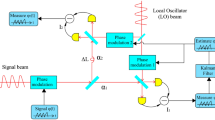Abstract
A high-precision frequency measurement method combining π-type delay chain and different frequency phase coincidence detection is proposed based on different frequency phase comparison. A delay chain is used to delay the frequency standard signal. The coarse delay can generate more phase coincidence points at the key position of the reference gate, which can easily form a high-precision actual gate and realize a fast response time of the frequency measurement. The fine delay can achieve an ultra-high measurement resolution better than picoseconds without changing the frequency relationship between the frequency standard signal and the measured signal. The experimental results show that the proposed method has a high frequency accuracy and stability. Compared with the traditional frequency detection method, it has the advantages of simple circuit, fast measurement speed, and high measurement accuracy. Therefore, it can be widely used in satellite navigation, space positioning, metrology, communication, precision time–frequency measurement, and other fields.






Similar content being viewed by others
References
Yu, X. Y., Zeng, H., Tian, S. L., Guo, L. P., Jiang, J., & Zuo, J. (2023). Research on a method of high precision frequency measurement based on coordinate rotation digital computer algorithm and Kalman filte. Review of Scientific Instruments, 94(2), 025106.
Jian, B., Bernard, J., Gertsvolf, M., & Dubé, P. (2023). Improved absolute frequency measurement of the strontium ion clock using a GPS link to the SI second. Metrologia, 60, 015007.
Meynard, A., & Wu, H. T. (2021). An efficient forecasting approach to reduce boundary effects in real-time time-frequency analysis. IEEE Transactions on Signal Processing, 69, 1653–1663.
Jiang, Z. H., Zhang, V., Parker, T. E., Petit, G., Huang, Y. J., Piester, D., & Achkar, J. (2019). Improving two-way satellite time and frequency transfer with redundant links for UTC generation. Metrologia, 56, 025005.
Formichella, V., Galleani, L., & SignorileSesia, G. I. (2021). Time–frequency analysis of the Galileo satellite clocks: Looking for the J2 relativistic effect and other periodic variations. GPS Solutions, 25, 56.
Wang, D., Zhang, X. D., An, X., Ding, Y. J., Jq, L., & Dong, W. (2023). Microwave frequency measurement system using fixed low frequency detection based on photonic assisted brillouin technique. IEEE Transactions on Instrumentation and Measurement, 72, 1–10.
Dorozhovets, M., Pawłowski, E., & Świsulski, D. (2023). Frequency measurement research with weight averaging of pulse output signal of voltage-to-frequency converter. Measurement, 216, 184–193.
Yang, G., & Liang, H. (2018). Adaptive frequency measurement in magnetic resonance coupling based WPT system. Measurement, 30, 318–326.
Chen, Y., & Shi, T. X. (2022). Simplified Doppler frequency shift measurement enabled by Serrodyne optical frequency translation. IEEE Microwave and Wireless Components Letters, 32(5), 452–455.
Gonzalez, D. A., Sergiyenko, O., Balbuena, D. H., Tyrsa, V., Kartashov, V., Lopez, M. R., Quiñonez, J. R., Fuentes, W. F., & Rico, F. N. M. (2018). Constraints definition and application optimization based on geometric analysis of the frequency measurement method by pulse coincidence. Measurement, 126, 184–193.
Parker, T. E., Zhang, V., Petit, G., Yao, J., Brown, R. C., & Hanssen, J. L. (2022). A three-cornered hat analysis of instabilities in two-way and GPS carrier phase time transfer systems. Metrologia, 59, 035007.
Du, B. Q., Li, S. L., Huang, G. H., Geng, X., Li, Z., Deng, R., & Mo, C. H. (2018). High-precision frequency measurement system based on different frequency quantization phase comparison. Measurement, 122(7), 220–223.
Galleani, L., Signorile, G., Formichella, V., & Sesia, I. (2020). Generating a real-time time scale making full use of the available frequency standards. Metrologia, 57, 065015.
Rovera, G. D., Siccardi, M., Römisch, S., & Abgrall, M. (2019). Time delay measurements: Estimation of the error budget. Metrologia, 56, 035004.
Du, B. Q., Li, S. L., & Sun, X. Y. (2019). Precise Doppler shift measurement method based on motion radiation sources. Measurement, 136, 275–281.
Garbin, E., Defraigne, P., Krystek, P., Piriz, R., Bertrand, B., & Waller, P. (2019). Absolute calibration of GNSS timing stations and its applicability to real signals. Metrologia, 56, 01501.
Guang, W., Zhang, J. H., Yuan, H. B., Wu, W. J., & Dong, S. W. (2017). Analysis on the time transfer performance of BDS-3 signals. Metrologia, 57, 065023.
Acknowledgements
This work was funded by the National Natural Science Foundation of China (No. 62173140); Hunan Key R&D Program Project (No. 2022GK2067); Natural Science Foundation of Hunan Province (No. 2021JJ30452).
Author information
Authors and Affiliations
Contributions
BD analyzed the principle and proposed the project and wrote the paper. WL analyzed the experiment data and performed the experiments and system test.
Corresponding author
Ethics declarations
Conflict of interest
The authors declare no competing interests in this work.
Data availability
The authors confirm that the data supporting the findings of this study are available within the article or below mentioned references.
Ethical approval
The authors declared that the manuscript ethics is approved as per the journal.
Consent for publication
The authors gave consent for publication as per the journal standard.
Additional information
Publisher's Note
Springer Nature remains neutral with regard to jurisdictional claims in published maps and institutional affiliations.
Rights and permissions
Springer Nature or its licensor (e.g. a society or other partner) holds exclusive rights to this article under a publishing agreement with the author(s) or other rightsholder(s); author self-archiving of the accepted manuscript version of this article is solely governed by the terms of such publishing agreement and applicable law.
About this article
Cite this article
Du, B., Li, W. A high-precision frequency measurement method combining π-type delay chain and different frequency phase coincidence detection. Analog Integr Circ Sig Process 118, 147–155 (2024). https://doi.org/10.1007/s10470-023-02220-5
Received:
Revised:
Accepted:
Published:
Issue Date:
DOI: https://doi.org/10.1007/s10470-023-02220-5




